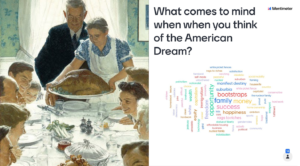Zooming Out: 6 Lessons COVID Taught Me About DH in the Classroom
by Tori Hoover, Mellon Graduate Fellow, English & CMAP
I stood before the class and smoothed my sweaty palms down the front of my dress. My hand trembled as I looked at my creased class list, and I quickly placed it on the podium. It was my first day teaching a class, and it was the first day of the 2020 Spring semester.
As the weeks went on, I gained confidence. I got to know my students. By the time we rolled into spring break, I’d finally begun to feel comfortable at the front of the classroom. I’d finally gotten into a groove.
And then… Well, you know what happened. On our first day back from break, a student tested positive for coronavirus. Classes were suspended for a week, then for two weeks, and then students were sent home. Campus was awash in chatter and excitement and then fell suddenly and eerily silent. Trash cans overflowed with empty Arizona teas and mounds of used mounting putty. Duffle bags were sat on, zipped, and tossed into trunks, bulging with unworn spring dresses and sandals. At home, as I kneaded dough for bread, my phone flashed with text after text as my cohort celebrated an extended spring break. Or so we thought.
Thus began three semesters of online teaching and learning. I learned to use Zoom. I taught my own sections as a TA and met with students privately about their work. I sat in courses of my own, struggling through technical difficulties as my classmates froze mid-sentence and screen-shared videos lagged. And in this dual position as both teacher and student, I learned a few valuable lessons about what teaching can look like in a digital space — lessons that have continued to benefit me even as we’ve returned to in-person classwork this semester.
- Students enjoy collaborative, interactive digital learning — and it can be transferred to in-person coursework surprisingly well. Remote learning has opened my eyes to a host of digital tools that I’m still using with my in-person classes. In my class on literary non-fiction, students used Perusall to collaboratively listen to Serial. Their comments on the episode helped me craft class discussion; as an instructor, I was able to reply and upvote their annotations, and they were able to reply to one another, too. Another tool I used for remote learning was Mentimeter, which allows the user to conduct live polls. I’ve used the tool in person as a discussion starter for the class; we’ve unpacked the mythic American Dream through the use of a word cloud, and while teaching Serial, I was able to keep track of what students thought of the case across multiple class meetings by polling their opinions.

- Digital projects bring out the best of students’ creativity. As a TA in a communications course last fall, I was lucky to enjoy a huge variety of projects from students. One student covered developing news stories over the course of the semester by making TikToks that utilized memes from that point in the app’s lightspeed trend cycle. Another student created a collage of contemporary video news footage, which they paired with an essay they’d written about the vilification of Asian Americans during historical pandemics. Multiple others created podcasts about topics they found interesting. The takeaway? For students raised in the Internet Age, digital projects open an enormous playground where creativity and scholarship can combine in extraordinary ways.
- Desktop PowerPoints don’t have to be the default. When we teach remotely, how do we make our lessons equitable for various types of learners? In the case of students who struggle with auditory learning, I learned from classmate and 2020-21 DH scholar Wendy Timmons that Microsoft’s live transcription abilities are seriously amazing; the software not only transcribes in the language being spoken but also provides on-the-spot translation into a bevy of different languages. Turns out something as simple as choosing a different presentation platform over Google Slides can result in huge gains in student comprehension.
- The world of virtual archives is vast and varied. My own remote graduate coursework has helped me explore the world of digital archiving, from early modern recipe books to French cross-dressing postcards to wanted ads for self-manumitted slaves. While we still have a long way to go in transferring archives to a digital space, there truly is a wealth of material available at our very fingertips, and these sites can be a great way to introduce students to primary sources.

- Multi-modal content really does keep things interesting. One of the primary ways I utilize DH in the classroom is by walking my students through comparative readings of different types of texts. For instance, we’ve talked about musical sampling as a form of allusion through collaborative Spotify playlists and corresponding explanatory comments via Google docs. We’ve compared multiple filmic adaptations of In Cold Blood alongside the text itself, and have considered the Serial case by noting important landmarks with StoryMaps. These approaches leverage multiple forms of media and appeal to a variety of learning styles, making for a diverse and engaging learning experience.
- The most important lesson of all: Socially distant teaching doesn’t have to mean emotionally or cognitively distant learning. In a time when we’re all mentally and emotionally exhausted, when students juggle extracurriculars with classwork on top of existential worries about an ongoing global pandemic, classroom connections established through creative applications of digital humanities can help ensure that students learn as productively as possible — while also feeling seen and supported in a difficult and lonely era. And there’s nothing more crucial than that.